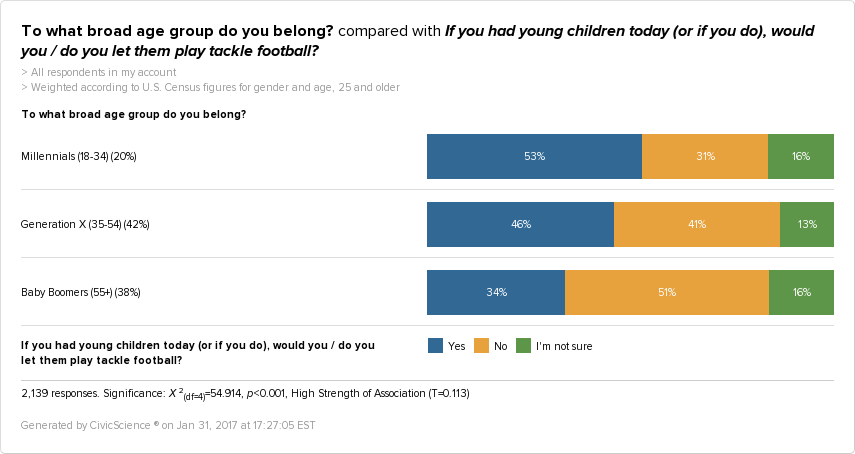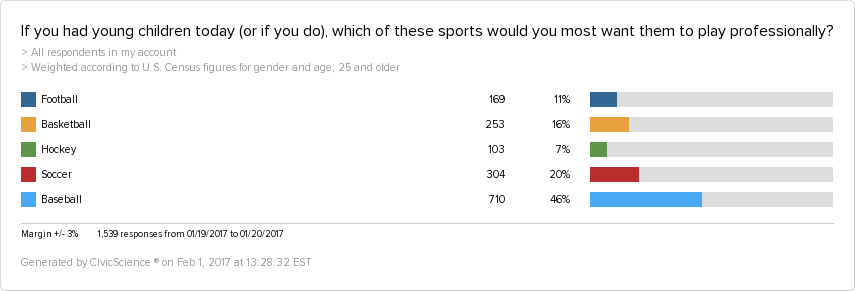It’s been something of a tumultuous season for the NFL, to put it mildly. From the National Anthem protests that began in the pre-season, to a flurry of non-competitive games, and a messy relocation of another team to Los Angeles – not to mention the dreadful TV ratings that came with it – the league’s 51st season is probably one Roger Goodell would like to forget. And that’s even before Goodell hands the Lombardi Trophy (probably) to a spiteful and smug Tom Brady in front of the entire world.
Some of the league’s misfortunes weren’t of its own doing. An unprecedented political climate tore TV viewers away from watching sports and made people like Colin Kaepernick more polarizing than they normally would be. As we saw in our data, NFL ratings began to rebound nicely within a few weeks of the Presidential election. There’s reason to hope the league’s difficulties are short-term. But there are reasons to worry as well.
MAYBE WE SHOULD BLAME THE FRESH PRINCE
[shade-open-form]
Maybe the NFL’s bad 2016-2017 season started long before the pre-season. Perhaps you could go all the way back to Christmas Day 2015, when the film Concussion premiered in movie theaters. Though clearly not the first exposé on head trauma and CTE in the NFL, any movie starring Will Smith was sure to hit the mainstream. By the end of its theatrical run last spring, the film had raised public awareness of head injuries in the NFL to an all-time high.
It’s worth asking whether at least some of the NFL’s woes are a result of fan disillusionment over the health risks of its players and, more importantly, whether that disillusionment could threaten the long-term prosperity of the sport. At CivicScience, we have tried to study this issue from several angles, and the answer is a definitive…’Maybe!’
Let me show you.
TRACKING CONCUSSION CONCERNS OVER TIME
Let’s start by quickly reviewing some research we published in the Sports Business Journal all the way back in 2012:

Before Barack Obama had even won his second term, the issue of concussions in the NFL was prevalent enough to justify studying it. At the time, 24% of NFL fans said they were very concerned about the issue. 31% weren’t concerned at all. Concern was highest among women, Baby Boomers, the highly educated, and suburban dwellers. The most avid fans – younger men in particular – were by far the least concerned.
It’s one thing to be concerned for the welfare of a bunch of millionaire pro athletes. That doesn’t necessarily mean people will stop watching. Look at this question from 2013:

Here we see a different angle. Notice that the 31% who said “players are responsible for their own health” is the exact same percentage who said they weren’t at all concerned about the issue in our 2012 question. 57% of fans said they believed the league should do more to protect players, with 30% advocating for rule changes if necessary. Indeed, with new rules against helmet-to-helmet contact, hitting defenseless receivers, and attempts to discourage kickoff returns, the league made strides to appease this 30%.
But did any of the league’s efforts matter? Let’s look at the same original question we asked in 2012. However, this time the results are from fans we surveyed over the past few days:

With very subtle differences (all well within the survey’s margin of error), our most recent numbers appear virtually unchanged. All of the league’s positive PR efforts and rule changes don’t appear to have made a difference.
THE NFL’S GREATEST FEAR (AT LEAST IT SHOULD BE)
Many have argued – or at least surmised – that concussion-related concerns are partially to blame for the decline in NFL ratings. Unfortunately, with so many other negative circumstances surrounding the 2016-2017 season, it’s almost impossible to prove or disprove it. It may take consecutive years of declining ratings to truly diagnose the cause.
Maybe the NFL’s greatest risk has nothing to do with its TV ratings in 2016, 2017, or even 2020. What should concern Roger Goodell and team owners the most, is whether concussion fears could wipe out future generations of football fans – and football players – altogether.
With all the negative PR surrounding concussions in the NFL in recent years, I’ve wondered if hyper-protective Millennial and Gen X parents are steering their kids away from football. Today’s kids can’t even ride bikes around their driveways without a helmet on. Indeed, youth football participation is down as much as 14% from its peak in 2009, despite the NFL’s aggressive attempts to bolster those numbers.
When we asked U.S. adults (age 25+) whether they would allow their young kids to play football, this is what we found:

As you can see, 43% of respondents say they won’t/wouldn’t let their kids anywhere near the gridiron. When we dig deeper into our football question, however, the numbers are a little more positive. For one, current parents were much more likely than grandparents or non-parents to say Yes (48% Yes, 39% No). In the same vein, Millennials were much more likely than Boomers or even Gen Xers to say children should play football. See for yourself:
 Millennials, at a margin of 53% to 31%, are by far the most sympathetic toward football. The top-line numbers were strongly skewed by Baby Boomers, most of whom don’t have young kids anyway. If I’m Roger Goodell and I see those numbers, I’m uplifted – for a minute.
Millennials, at a margin of 53% to 31%, are by far the most sympathetic toward football. The top-line numbers were strongly skewed by Baby Boomers, most of whom don’t have young kids anyway. If I’m Roger Goodell and I see those numbers, I’m uplifted – for a minute.
But let’s ask this same question about another sport, say basketball:

The differences speak for themselves.
MAYBE THE NFL SHOULD WORRY ABOUT OUR ONE-SPORT CULTURE
One of my best friends is a retired NFL player and, incidentally, a two-time Super Bowl winner. Today he coaches an elite youth soccer club in Pittsburgh, and if you spend more than five minutes with him, you’re sure to hear him on his soapbox about one thing: The One-Sport Youth Culture. Today’s kids are forced to focus on just one sport at a very young age, the prevailing fear being that other kids will pass them by if they miss a single season. My friend would tell you that it’s terrible for the kids’ athletic development, their bodies, and their long-term health. It might also be really bad for the NFL.
CivicScience recently added the following question to our national tracking survey, targeting a representative sample of U.S. adults age 25 and older:

These results floored me. Baseball is almost as popular as the next three sports, combined. The NFL finishes a distant fourth. When we looked more closely, here are some of the things we discovered:
- Football does only slightly better among current parents at 12%, while soccer performs much better at 25%.
- Among Millennials, soccer (30%) climbs closer to baseball (31%). Football gets a minor boost to 14% – not the same jump we saw among Millennials in our other questions.
- Overall, football does slightly better among minorities, households making over $150k in annual income, and people living in rural areas.
One important thing to note is that even baseball has seen a well-documented decline in youth participation over the past several years – as most sports have. In fact, according to a thorough Sport and Fitness Industry Association study, youth sports in America saw an overall drop of 9.09% between 2009 and 2014. Baseball’s decline was less than half that, at 4.3%. What was tackle football’s decline during the same period? 17.9%.
WHAT DOES IT ALL MEAN?
Admittedly, parents only have so much say over the life-long hobbies that their children choose. Otherwise, I wouldn’t swear or drink as much as I do. But parental influence is non-trivial in determining the earliest choices kids make about sports, hobbies, and overall lifestyle. My oldest daughter sings, in large part, because I do. My youngest daughter is a gymnast because my wife was a gymnast, judge, and coach. If parents are more likely to steer their child toward other sports over football, the impact of that could be significant, especially in a world where kids choose one and only one sport at an early age. The NFL may have a lot to worry about, if they can’t convince parents that football is safe.
At the same time, maybe sports don’t need a robust youth athletics system to be popular among spectators? NASCAR does okay and I don’t know a lot of ten-year-olds zipping around race tracks at 100 miles per hour. Where are all the kids doing MMA in their backyards?
Maybe the NFL can survive a persistent decline in youth participation and maintain its status as an entertainment juggernaut. It’s just hard to see how the league will continue to flourish like it has in recent memory. Maybe the sub-par ratings we saw in 2016 were, in fact, partly attributable to parents’ concussion fears and eroding youth interest in the sport. And maybe it’s only the beginning.
Time will tell. Maybe.
[shade-close-form]








